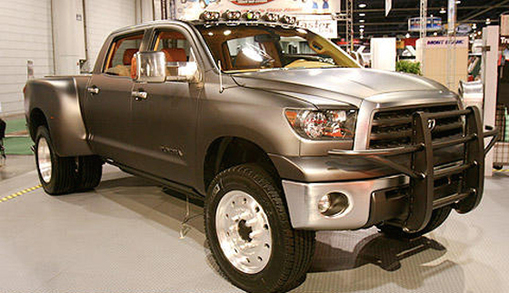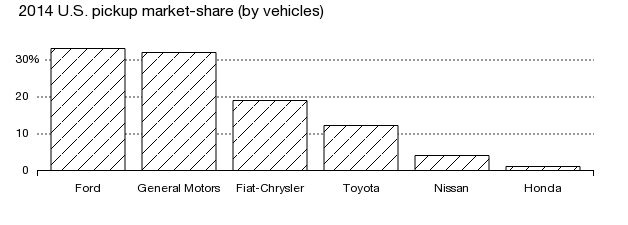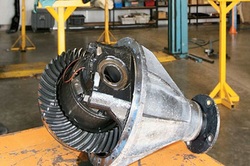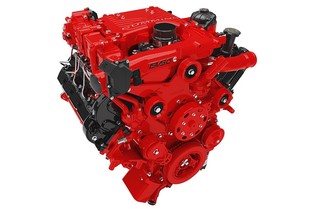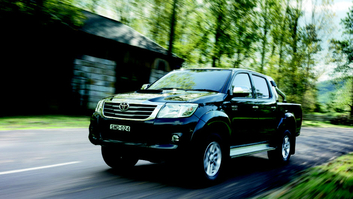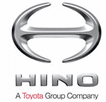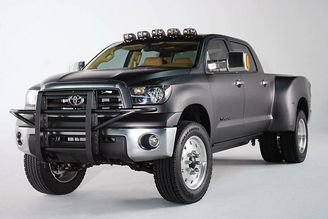|
At the 2007 SEMA show, Toyota revealed a Tundra Diesel dually concept truck. Ever since, questions abound about the Tundra Diesel: when will Toyota finally bring it onto the market? When it does, which kind of diesel engine will power the Tundra? Does Toyota have adequate diesel technology, or would it go elsewhere? To give you the inside track on Toyota's decision-making, we here at TundraDiesel.ca have decided to create this website. It contains information about the Tundra, Toyota diesel technology, and more. |
We have also composed a PDF that you can download for free. It contains some insider information we have decided not to make public on this website. This is information you won't find anywhere on the internet and we'd like to keep it that way. To receive this PDF for free, and learn more about our updates on the latest Tundra Diesel developments keeping you ahead of the pack, click the link below. Read on for more information about the Tundra and Toyota diesel technology.
The Toyota Tundra
|
When the Toyota Tundra arrived in 1999 it was received as a welcome addition to the half-ton truck section, garnering Motor Trend magazine’s Truck of the Year award in 2000 and 2008. It was the first full-size truck produced by Toyota as well as any Japanese manufacturer. At first, the new Tundra platform shared similarities with the older T100 and the compact Tacoma, such as the 3.4 liter V6 engine, although a 4.7 liter V8 engine was later added. When the second generation Tundra came out in 2007, it introduced the much more powerful 5.7 liter V8 engine, producing 381 horsepower (284 kW) and 401 pound-feet (544 N·m) of torque. The smaller 4.7 liter engine was kept as a carry-over and is still an option in some of the 2015 Tundra models. In Canada, CanadianDriver magazine declared the Tundra as “Truck King” in both engine options, pronouncing it the best out of all half-ton pickup trucks with 5.0 liters or lower, and 5.0 liters or higher engine displacement.
|
Truck buyers certainly took more notice of the Tundra after its 2007 redesign, when it received some of the more aggressive-looking features that have become characteristic of the full-size truck market. Nonetheless, the 'Detroit Three' dominate North American truck sales. Taking US sales in 2014 as an example, Ford, GM, and Fiat-Chrysler occupy the top three selling positions, whereas Toyota has a comparatively small share of the market at just above 10%.
Toyota has made a concerted effort at giving the Tundra an "American" image: it is built in Texas, arguably the heartland of North American pick-up truck culture as well as the new location of Toyota's headquarters in America. It's top-of-the-line Tundra carries a "1794" badge, which commemorates the year in which the Texan ranch was founded on which Toyota's factory stands today. Toyota favors the use of North American-made components in the Tundra. Ironically, the "Japanese" Toyota Tundra now contains the highest number of parts made in North America of all full-sized trucks on the market and is the only full-sized pick-up truck manufactured in Texas.
Tundra Excellence - Overbuilt
|
In pursuing excellence in its full-size pick-up truck, Toyota in fact overbuilt the Tundra. Let's take the rear-differential as an example: the Tundra carries a fully welded rear axle sporting a 10.5 inch ring gear with 4.30:1 ratio gears.
By comparison, this ring gear is the same size as that found in a Heavy Duty Ford F350 Dually; the only truck with a larger rear differential ring gear is the Heavy Duty RAM 3500 Dually with an 11.5 inch ring gear. No other half-ton truck comes close to the Tundra in rear differential strength.
|
The Tundra is also known to be good for modifications: it has a lot of suspension travel from factory and one of the highest ground clearances in the class, being able to run over-sized tires without having to re-gear. Not surprisingly, there is good aftermarket suspension support: from lowered, to long travel with 16” of wheel travel, to street queen lift kits. (By comparison, a Ford F-150 Raptor has 11.2” of front wheel travel and 13.4” rear wheel travel.) Built to last and reliable, the Tundra is perhaps the simplest of all half ton pick-ups. It forgoes some of the luxury features found in competitors, and at its heart is (currently) a naturally-aspirated gas engine. But it works hard for you and it will withstand a life of beatings, as shown e.g. by the Tundra put to work on the Anderson ranch in Western Texas for 100,000 miles.
Diesel Trucks
|
Pick-up
trucks, especially those built for work and towing, benefit from the
higher torque, better longevity and lower maintenance cost associated
with diesel engines. Not surprisingly, in the heavy-duty pickup section
diesel engines have been an option for years. Customers are able to
choose between Ford's Power Stroke, Ram's Cummins and Chevy/GMC Duramax
engines. In the light-duty, full-size pickup market, diesel options
have not been common until very recently.
RAM re-entered the light-duty diesel market with the 2014 RAM 1500 Eco-Diesel, equipped with a 3.0 liter turbo-diesel V6 engine. This engine is also used in the Jeep Grand Cherokee and will most likely find its way into other Chrysler models, promising much improved fuel efficiency ratings. The market responded positively to RAM's Eco-Diesel: sales have beaten original predictions, and then some. Instead of the expected 5-10% of RAM 1500 sales, Eco-Diesel orders have risen to a whopping 20% of RAM 1500 sales. |
The Eco-Diesel engine coupled to an advanced eight-speed transmission would seem to be a convincing product, offering 420 pounds-feet of torque and a maximum towing capacity of 9,200 pounds. Is it likely to motivate other manufacturers to move ahead with plans for light duty diesel engines in their own full-size or mid-size pick-up trucks?
|
Several diesel models are currently hitting the market, with new diesel trucks from Chevrolet, GMC, Ford, and Nissan either available now or becoming available in the next few years. The full-size Nissan Titan, for example, will be available shortly with a brand new 5.0 liter V8 Turbo-Diesel engine developed by Cummins. It will join the RAM 1500 as the only other full-size diesel truck. In the mid-size truck section, the 2016 Colorado and Canyon line-up, distributed by Chevrolet and GMC, will feature the highly anticipated 2.8 liter Duramax Turbo-Diesel engine. The Colorado/Canyon will be the first North American mid-size pickups to offer a turbo-diesel, but they may not stand alone for long: in 2014 Nissan presented its Frontier diesel project at the Chicago Auto Show.
|
Toyota Diesel Trucks Worldwide
|
In other parts of the world, Toyota has long established itself as a manufacturer of reliable mid-size diesel trucks. The famed, "indestructible" Toyota Hilux is available pretty much worldwide today, with the exception of North America, Japan, South Korea and North Korea. Diesel engines have been offered in Hilux trucks since 1979, ranging at first from 2.4 liter to 2.8 liter inline 4 cylinder engines. Toyota sold the Hilux in the US and Canada until 1995, when it was replaced by the Tacoma. In North America, Hilux diesels were discontinued in 1986 due to the availability of cheap gasoline and the emerging dominance of V6 engines in the truck market. In South America, Hilux diesels are available in all markets apart from Colombia, Ecuador and Venezuela. Hilux trucks were built in Argentina from 1997 through 2005 for sales in Argentina, Brazil, and Uruguay. Diesels imported from Japan were sold in Bolivia, Chile, Paraguay and Peru.
|
In 1998, Toyota introduced the 3.0 liter inline 4 cylinder diesel engine in South America. Hilux units sold in South America are still made in Argentina today, while the engines are now built in Japan. Thailand became the global production and export hub for the Hilux in the late 1990s. The sixth generation Thailand-made Hilux, named the Hilux Tiger, was also offered with diesel engine options. Today, the Thailand-made Hilux models are sold under the Vigo label in Australian, Middle Eastern, and Asian markets. For the European and South African markets, the Hilux is built in Durban, South Africa, and is the best selling vehicle in South Africa as of December 2009.
 Commonrail diesel engine.
Commonrail diesel engine.
Since 2001, the Hilux has been equipped with the Toyota D-4D diesel engine. The Hilux Vigo range is powered by either the 2.5 liter or the 3.0 liter D-4D direct injection turbo-diesel engine. The 3.0 liter D-4D is the latest incarnation of the renowned diesel engine powering the flagship Toyota Land Cruiser range. It is a direct injection, 4 cylinder common rail diesel engine. Common rail diesels inject a fine mist of fuel into the engine at very high pressure, feeding all four cylinders from one rail (older diesel engines have a separate pipe leading from the pump to each cylinder). This results in similar power output to gasoline engines, but providing better fuel efficiency and lower emissions. In addition, the computer control unit injects a small amount of fuel into each cylinder before the main fuel load ignites. This "pilot burn" lowers the explosive force of the main combustion process and reduces the noise and vibration formerly associated with diesel engines. The electronic control in common rail engines also eliminates the need to wait for glow plugs to heat up before starting the engine. The exact, computer-controlled injection timing and fuel measurement in Toyota's D-4D engines lead to cleaner burning and lower emissions, meeting European Step III regulations. Since there is less fuel wasted though inefficient combustion, the D-4D delivers improved fuel economy over Toyota's earlier diesel engines. Both the 2.5 and 3.0 liter versions of this engine have a proven track-record as highly versatile engines the world over, powering the new Prado, sold in the Middle East and Asia, as well as the Toyota Hilux, Vigo, Toyota Hiace and the Toyota Fortuner.
Toyota's Hino
|
Toyota's expertise with diesel engines doesn't end with the Hilux. Hino Motors Ltd., one of 16 major companies of the Toyota Group, has 100 years of experience producing medium and heavy-duty diesel trucks in Asia. Hino manufactures trucks in the US and Canada as well as Thailand and has sales networks in North America, where it has been marketing trucks since the 1970s. Hino also built the FJ Cruiser for Toyota from 2006 to 2014, as well as being responsible for the diesel engine inside the 2007 SEMA Tundra Diesel dually concept. It still builds rear-end components for the Tundra today.
|
|
Hino has long-standing expertise in developing and manufacturing hybrid vehicles. It delivered the world's first hybrid bus in 1991. Today, Hino has the highest cumulative hybrid-vehicle sales globally. In 2012, Hino introduced cab-over diesel-electric class 5 trucks, making diesel-electric hybrids a viable option in the U.S. commercial truck market for the first time. Based on six generations of technology evolution and more than 10,000 production vehicles already on the road around the world, the diesel hybrid was designed from the ground-up for the US market.
|
 Toyota Hino Hybrid Diesel Engine System.
Toyota Hino Hybrid Diesel Engine System.
With its Hybrid System Power Control Unit, this engine features the world's first Hybrid Adaptive Control System that continuously communicates with the engine control unit (ECU) to evaluate driving and road conditions to optimize the truck's fuel economy and performance. It also features a new power-line configuration, in which the clutch is positioned between the engine and the motor, enabling more efficient energy recovery than in previous hybrid systems. Its torque-inverted automatic transmission was designed specifically for the North American market. The engine, hybrid control system and transmission communicate with one another to work in unison, to continuously operate at optimum level for fuel efficiency. Matching speeds of engine and motor allows for smooth shifting, maximizing fuel efficiency and performance under a wide variety of conditions. The amount of motor assist is continually adapted to fit the driving situation. The diesel hybrid does not need a starter motor, since engaging the clutch starts the electric motor. At cruising speed, the engine is in its most efficient mode and the electric, battery-fed component shuts off. During braking, vehicle deceleration energy is converted into electricity and stored in the nickel–metal hydride battery. The clutch automatically disengages, allowing maximum efficiency in battery-stored energy regeneration. Overall, Hino's diesel-electric hybrid produces 30% better fuel economy than comparable diesel engines.
The Tundra Diesel
|
The diesel-driven changes afoot in the North American truck market beg the question: when will Toyota bring out a Tundra Diesel? The Tundra (like all Toyota vehicles) is a quality product. Combining Tundra's proven track record of reliability with the longevity of a diesel engine appears to be a no-brainer. The Tundra has taken its time breaking into the most competitive and loyal of markets in North America. It has had some minor missteps along the way, but it has been building a loyal following. Many of these followers were ecstatic when Toyota presented a dually Tundra Diesel concept with a Hino engine at the SEMA show in 2007. At the time, Toyota promised to build a Tundra diesel within the next three years, but the economic downturn and falling sales stalled these plans and eventually led to Toyota shelving them altogether.
|
Overall, it is safe to say that Toyota has been conservative with the Tundra, watching competitors' moves before making drastic changes. It is getting the important things right and correcting mistakes along the way. The company is refining its product and is far from quitting the pick-up truck competition. Toyota also seems to have plenty to choose from at home and overseas when it comes to diesel technology - including diesel hybrid technology. So when can we expect the Tundra diesel? Will it be a hybrid or a straight diesel? Is it going to arrive in 2016 to compete with the Nissan Titan's 5.0 liter Cummins diesel? The rumor mill has been spinning a marriage of the same Cummins engine with the Tundra since early 2014. However, although we know a diesel-powered Nissan Titan is definitely coming for the 2016 line-up, the story linking Toyota with Cummins has never been confirmed.
The good news is that here at TundraDiesel.ca, we are at the pulse of Toyota's decision-making. We have composed a PDF with the latest information available, including insider information you won't find anywhere on the internet. In this file, we will share information with you that will put you ahead of the pack. If you'd like to read it and be among the first to receive updates on whether and when the Tundra Diesel will arrive in North America, just enter your email address below and click submit - you will receive an email with the PDF file within minutes!
© tundradiesel.ca 2021. All rights reserved.
